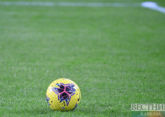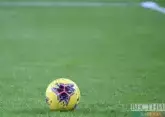The greatest success for the national football teams of the Soviet Union and Russia at the world championships were 1966 bronze medals. Back then, the team was led by Nikolai Morozov, its players were from Moscow, Kiev, Tbilisi, Baku, Rostov and one each from Leningrad and Minsk. The Caucasian footballers stood out in their virtuosic and technical skills. Seven trainees from the Caucasus took the field in matches that season.
Most of the games for the national team in 1966 were conducted by the Neftyanik Baku striker (since 1968 - Neftchi) Anatoly Banishevsky - 13 games, of which five - at the World Cup in England. He scored four goals that year, including two - at the championship, during the first and in the last matches.
Experts call Anatoly Banishevsky the most legendary football player of Azerbaijan. At the beginning of the 21st century, marking the Union of European Football Associations (UEFA)'s 50th anniversary, the countries that are members of the union named their best player. The Azerbaijani Football Federation made a decision quickly - Banishevsky. He was not only a brilliant football player, but also a patriot of his republic. Leading Soviet clubs dreamed of seeing Anatoly in their ranks, offering him to move to Moscow and Kiev. But Banishevsky remained faithful to his native city and club, even in the early 1970s, when Neftchi was forced to be in the first league for five seasons.

Anatoly Banishevsky
The Baku striker marked a place for himself in the football history books thanks to a goal against Brazil at the Maracanã stadium scored from almost 40 meters with his head! Even this arena, one of the largest in the world, never seen this before. "Anatoly Banishevsky was, of course, the jewel of both the national team and the Baku football. The 1966 championship was the first one where I worked as a journalist. Back then two people from Baku, Anatoly Banishevsky and Eduard Markarov, played in the national team. I remember that we all lamented: why they are not allowed to play together? Only each after each. But they were strong when being paired up, because they achieved good team-work while playing in Neftyanik. But no one has yet replicated the success of 1966, when the national team made it to the top-4. And that year the Baku Neftyanik had the biggest achievement in the country's championships - the third place," the journalist and writer Valery Vinokurov said.

Anatoly Banishevsky and Muslim Magomayev - two great Baku natives
During the "bronze season," Eduard Markarov played two matches in the national team, one - at the World Championships against Chile. The Soviet team won 2:1. Before the 1966 World Cup started, authoritative sports journalist Yuri Vanyat prophetically wrote in the newspaper Trud: "In late May it is advisable to see the team members with a more rational staging of the final kick. Plus, shouldn't you try the 'Baku option' on the offence positions: Banishevsky-Markarov. The performance of our "Pele from Baku," Eduard Markarov, was great this spring. "

Eduard Markarov on the right

Other five Caucasians in the Soviet team were from Georgia, if consider that Moscow Torpedo player Anzor Kavazashvili was also from this republic. During that season, striker Slava Metreveli was the most popular player from the "Georgian team."

Slava Metreveli and Lev Yashin
He played 8 games in the national team, of which two - at the World Cup. He took part in the match for third place against Portugal. During the games he interacted with Eduard Malofeev and Victor Serebryanikov. Eduard Streltsov, who was banned from travel abroad after imprisonment, with which Metreveli achieved good team-work while playing in Moscow's Torpedo, was not allowed to join the team at that Cup. Perhaps, in this case the national team's performance would have been more effective in England. Metreveli then failed to hit the rival team's goal.

Captain of the Soviet Union national team Murtaz Khurtsilava
Another Georgian football star was defender Murtaz Khurtsilava - who later became the captain of the Soviet Union team. He took part in six games, three of which were in England against strong opponents: Italy, Portugal and the DPRK (the North Korean team beat the Italian team 1-0 in the group stage, but lost 5–3 to Portugal in the quarter-final, with a goal scored in the first minute, and then leading 3-0, but the ball wizard Eusebio scored four goals, and at the end of the game Augusto increased the goal difference). Murtaz Khurtsilava was one of the few players of the "English" national team of the Soviet Union, who played at the next championship, four years later in Mexico (except for him, Gabriel Kachalin's team included Lev Yashin, Anzor Kavazashvili and Viktor Serebryanikov).

George Sichinava vs. Pele
Georgian football players, like those from Kiev, were represented in all game lines in 1966. Giorgi Sichinava was midfielder, feeling himself confident with two games in the Cup, but the most responsible ones: the starting game with the DPRK, and the final one with Portugal. He would have played more, if it wasn't for the injury during the first game. The next Sichinava's game was already after the championship, with the Yugoslav team (2:1). He was inventive not only in sport, but also in life. Many years later, Sichinava told about the Soviet footballers' secret "commercial operation" in England. The Puma representatives contacted them, promising 10 thousand dollars to anyone, who will enter the field wearing their boots. They shook hands with Puma on it. A week later, people from Adidas contacted them as well, and offered twice that many. The way out of the seemingly difficult situation was found by Sichinava. He suggested every football player to wear two different boots at the training, attended by the representatives of both competing firms. Both Puma and Adidas representatives laughed for several minutes, but did not ask to get their money back.

Mikhail Meskhi - an author of filigree tricks
Sports journalists regretted in 1966 that Mikhail Meskhi, who was in very good shape then, did not go to the championship. In 1966, he participated in two friendlies before the championship - against Chile in February (2:0) and against Switzerland in April (2:2). However, the Tbilisi forwarder did not score any goals then. But until now, football professionals remember Meskhi's famous trick. According to the then editor-in-chief of the Football-Hockey weekly, Lev Filatov, Meskhi's agile and original play sometimes evoked the laughter of the fans - he was good at "mocking" his opponent. But many trainers did not like this originality, and they accused him of playing to the gallery, which, possibly, influenced the coaching staff's decision in 1966.

Anzor Kavazashvili and Pele
The Soviet national team's goal area in the English Cup was defended by Lev Yashin and Anzor Kavazashvili - the most reliable goalkeepers in the country that time. In four games of the Cup Lev Ivanovich missed five goals, Anzor Amberkovich - only one in two games. If in 1966 Yashin was declared the main goalkeeper, then in 1970 - Kavazashvili. He entered the history of domestic football as a goalkeeper, who didn't miss a goal in 163 games. Twice in the USSR he became the best goalkeeper of the year.
Anzor Kavazashvili was a Komsomol leader of the Soviet team at the English Championship - the second-ranking player after the captain that time . The coaching staff took the most serious decisions with the participation of the Komsomol leader.
"In England, we lived almost without leaving and completely isolated in some boarding house in Sunderland - almost at the border with Scotland. We did not even go beyond the gates. Only the final match was played at Wembley, and then we moved to London. After two our victories over the DPRK and Italy, I was invited by the coaching staff to meet with the North Korean delegation. The head of this delegation and party leaders came to us. They asked us to win the third game, those against Chile, which was not of great importance for us, but it would allow the DPRK to be second in the group and enter the quarterfinals. The Korean comrades presented each Soviet football player and coach a gift as a token of gratitude - a ginseng extract bottle. Money was not motivation those days, only souvenirs! By the way, we beat the Chileans with a score of 2:1, but the North Koreans distinguished themselves as well, beating the Italians 1:0," Anzor Kavazashvili told me.
Of the seven Caucasians of the 1966 Soviet national team the current championship in Russia will be observed by four. Three of them - Banishevsky, Metreveli and Meskhi - are no longer amongst us. Anzor Kavazashvili and Eduard Markarov live in Moscow, Murtaz Khurtsilava - in Tbilisi, Giorgi Sichinava - in Sochi. It turned out that none of them - the players of the most successful national team in the history - were not invited to the opening ceremony at Luzhniki Stadium. Former CSKA player Vladimir Ponomarev, as an active participant in the veteran football movement, and not the 1966 bronze medal winner, receives invitations to matches and festive events more often than others, but he, as he told me recently, usually sits "somewhere in the sixth row," while the first row is occupied by functionaries, "famous actors and parodists," And here we are, the domestic football lost its leadership in rankings. I am convinced that there is a direct link between these facts.










